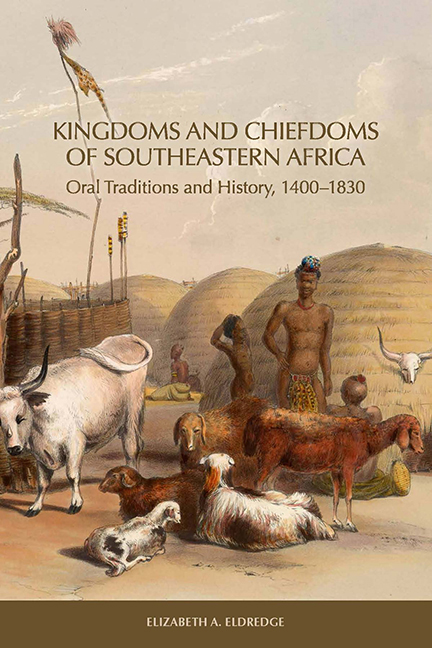Book contents
- Frontmatter
- Contents
- List of Illustrations
- Preface
- 1 History and Oral Traditions in Southeastern Africa
- 2 Oral Traditions in the Reconstruction of Southern African History
- 3 Shipwreck Survivor Accounts from the Sixteenth and Seventeenth Centuries
- 4 Founding Families and Chiefdoms East of the Drakensberg
- 5 Maputo Bay Peoples and Chiefdoms before 1740
- 6 Maputo Bay, 1740–1820
- 7 Eastern Chiefdoms of Southern Africa, 1740–1815
- 8 Zulu Conquests and the Consolidation of Power, 1815–21
- 9 Military Campaigns, Migrations, and Political Reconfiguration
- 10 Ancestors, Descent Lines, and Chiefdoms West of the Drakensberg before 1820
- 11 The Caledon River Valley and the BaSotho of Moshoeshoe, 1821–33
- 12 The Expansion of the European Presence at Maputo Bay, 1821–33
- 13 Southern African Kingdoms on the Eve of Colonization
- Appendix A Ama Swazi King Lists
- Appendix B Chronology of Conflicts, Migrations, and Political Reconfiguration East of the Drakensberg in the Era of Shaka
- Appendix C Interviewees from the James Stuart Collection of Oral Traditions
- Notes
- Bibliography
- Index
3 - Shipwreck Survivor Accounts from the Sixteenth and Seventeenth Centuries
Published online by Cambridge University Press: 14 March 2018
- Frontmatter
- Contents
- List of Illustrations
- Preface
- 1 History and Oral Traditions in Southeastern Africa
- 2 Oral Traditions in the Reconstruction of Southern African History
- 3 Shipwreck Survivor Accounts from the Sixteenth and Seventeenth Centuries
- 4 Founding Families and Chiefdoms East of the Drakensberg
- 5 Maputo Bay Peoples and Chiefdoms before 1740
- 6 Maputo Bay, 1740–1820
- 7 Eastern Chiefdoms of Southern Africa, 1740–1815
- 8 Zulu Conquests and the Consolidation of Power, 1815–21
- 9 Military Campaigns, Migrations, and Political Reconfiguration
- 10 Ancestors, Descent Lines, and Chiefdoms West of the Drakensberg before 1820
- 11 The Caledon River Valley and the BaSotho of Moshoeshoe, 1821–33
- 12 The Expansion of the European Presence at Maputo Bay, 1821–33
- 13 Southern African Kingdoms on the Eve of Colonization
- Appendix A Ama Swazi King Lists
- Appendix B Chronology of Conflicts, Migrations, and Political Reconfiguration East of the Drakensberg in the Era of Shaka
- Appendix C Interviewees from the James Stuart Collection of Oral Traditions
- Notes
- Bibliography
- Index
Summary
Written European sources from as early as the fifteenth century provide eyewitness evidence of chiefdoms and chiefs in southeastern Africa. The accounts confirm that the sociopolitical organization of ancestral Ngunispeaking peoples from before the first European witnesses encountered them consisted of chiefdoms in which authority was vested in a chief, and the territorial extent and limits of his authority was known and recognized. Familiar patterns of mixed farming involving cultivation and pastoralism were already present, and the chief held decision-making powers over settlement and land resources, hunting, trade, and interaction with other chiefs and chiefdoms, including the mustering of armed men when necessary for offensive or defensive purposes. The evidence demonstrates in and of itself that these societies had not and did not develop in isolation. Not only did European eyewitness accounts record what they were told about links, often tenuous, between chiefdoms, but also the various parties of shipwreck victims who traveled across the area over the next three centuries introduced the peoples they met to many aspects of the cultures they represented. Hailing from Europe, India, the Far East, and East Africa, these exhausted travelers interacted openly with villagers and chiefs across southeastern Africa, from whom they received food and information and guidance and with whom in exchange they left not only remnants of material culture—iron goods, cloth and garments from India and Europe, and trinkets—but also knowledge of the Christian God and Savior and the symbol and symbolism of the Cross.
After the first Portuguese ship reached the southern tip of Africa in 1488 and the ships of Vasco da Gama rounded the tip of South Africa in 1498 the Portuguese Crown supported traders and adventurers who created a vast trading empire based in what was referred to as Portuguese India. The ships of Portugal reached enormous size to accommodate the pepper and spices, cloths, and other trade goods from India and beyond.
- Type
- Chapter
- Information
- Kingdoms and Chiefdoms of Southeastern AfricaOral Traditions and History, 1400–1830, pp. 54 - 88Publisher: Boydell & BrewerPrint publication year: 2015



